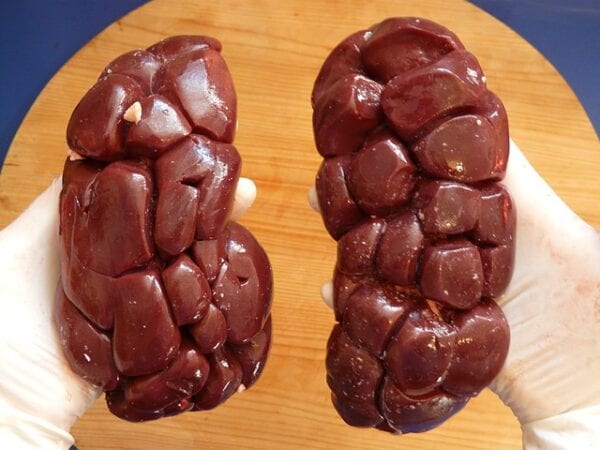Last week, the FDA approved finerenone (Kerendia) to treat patients with chronic kidney disease (CKD) associated with type 2 diabetes. Finerenone is a nonsteroidal mineralocorticoid receptor antagonist (MRA). The approval of finerenone was due to the results of the recently completed FIDELIO-DKD trial, which demonstrated the protective effects of finerenone.
How does it exhibit these protective effects? The mineralocorticoid receptor (MR) is involved in fluid, electrolyte, and hemodynamic stability, and overactivation of the MR – such as in type 2 diabetes and CKD – causes high levels of inflammation and fibrosis. This leads to end-organ damage in cardiorenal disease. Finerenone is a potent antagonist selective for the MR, leading to reduced proinflammatory and profibrotic gene expression. The nonsteroidal structure allows it to bind uniquely to the MR with equivalent potency as spironolactone and more selectivity than eplerenone, both steroidal MRAs, while causing a decreased incidence of hyperkalemia, which is one of the largest concerns during MRA use.
FIDELIO-DKD was a randomized, double-blind, placebo-controlled, multicenter clinical trial with just over 5700 patients with DKD enrolled. Patients were required to be on a maximum tolerated dose of ACE-inhibitor or ARB, and those with symptomatic HFrEF were excluded. During the follow-up period of almost 3 years, 504 out of 2833 patients (17.8%) treated with finerenone, compared to 600 of the 2841 patients (21.1%) receiving placebo treatment, experienced the primary composite outcome of kidney failure, a decrease of at least 40% in eGFR sustained for at least 4 weeks, or death from renal causes. This means patients on finerenone were 18% less likely to experience this primary outcome.
FIDELIO-DKD also studied cardiovascular outcomes while on finerenone therapy, and 45.9% of the patients enrolled in this study had baseline cardiovascular disease. Patients receiving the drug were found to have a 14% reduced risk of cardiovascular death or non-fatal cardiovascular events (myocardial infarction, stroke, or hospitalization for heart failure) compared to the patients receiving placebo.
Adverse events of MRAs have typically been a limiting factor in their usage, specifically hyperkalemia, and gynecomastia. With finerenone, patients who had to discontinue use due to hyperkalemia were higher (2.3%) than patients receiving placebo (0.9%). The risk for hyperkalemia seems to be lower with finerenone than with the other MRAs, however. In a phase II trial of finerenone (ARTS-DN), there were only small changes in serum potassium levels and a low incidence of hyperkalemia, thus a small number of discontinuations necessary due to hyperkalemia, which has been a limiting factor in the usage of earlier MRAs, spironolactone and eplerenone. Another use-limiting adverse effect of MRAs is gynecomastia. The mechanism behind this effect is a nonspecific interaction with the homologous androgen receptor. Due to finerenone’s nonsteroidal structure and specificity for the MR, gynecomastia has not been reported as an adverse effect.
So where will finerenone fit into clinical practice? It may be some time before prescribers reach for it first line in DKD due to the other treatment options with more established results, especially SGLT-2 inhibitors. The two SGLT-2 inhibitors approved for slowing renal disease have shown to be highly effective, and due to their relatively new use in practice, most participants in the FIDELIO-DKD trial were not on concomitant SGLT-2 inhibitors (less than 5%). Until we have more information on whether finerenone provides additional benefit to patients who are already on an ACEI or ARB plus an SGLT-2 inhibitor, finerenone may take a back seat to those options. For now, the concomitant use of finerenone with an SGLT-2 is considered experimental and it may be difficult to get insurance coverage for this combination. One area where it may shine, though, will be in patients who cannot tolerate or are contraindicated for SGLT-2 inhibitors.
Other populations where finerenone should be studied and may provide a benefit include patients with type 1 diabetes and those with HFrEF, as they were not included in this trial. Overall, the approval of finerenone is good news for healthcare professionals and patients with diabetic kidney disease as it provides one more option to help slow the progression of kidney disease in these individuals.
- 30 medication mistakes PDF
- 18+ Page Drug Interaction PDF
- 10 Commandments of Polypharmacy Webinar based on my experiences in clinical practice
This article was written by Lincoln Haiby PharmD Candidate in collaboration with Eric Christianson, PharmD, BCPS, BCGP
Study Materials and Resources For Healthcare Professionals and Students – Amazon Books
References:
Filippatos G, et al.; FIDELIO-DKD Investigators. Finerenone and Cardiovascular Outcomes in Patients With Chronic Kidney Disease and Type 2 Diabetes. Circulation. 2021 Feb 9;143(6):540-552. Epub 2020 Nov 16. Accessed July 15, 2021.
Bakris GL, et al.; FIDELIO-DKD Investigators. Effect of Finerenone on Chronic Kidney Disease Outcomes in Type 2 Diabetes. N Engl J Med. 2020 Dec 3;383(23):2219-2229. Epub 2020 Oct 23. Accessed July 15, 2021.
Zoler, M. L. FDA Approves Finerenone (Kerendia) for Slowing CKD in Type 2 Diabetes. Medscape; Medscape. 2021 Jul 12. Accessed July 15, 2021.
Ruilope LM, Agarwal R, Anker SD, et al. Design and Baseline Characteristics of the Finerenone in Reducing Cardiovascular Mortality and Morbidity in Diabetic Kidney Disease Trial. Am J Nephrol. 2019;50(5):345-356. Accessed July 15, 2021.



0 Comments
Trackbacks/Pingbacks